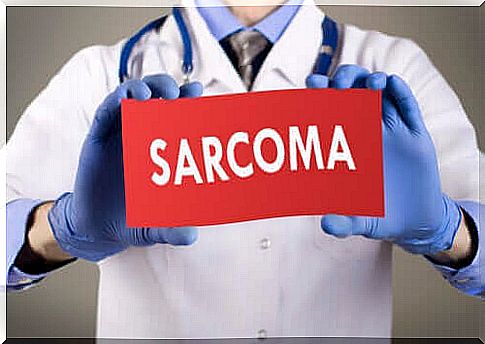Types Of Sarcomas And Their Characteristics
A sarcoma is a type of cancer that occurs in the soft tissues and bones. There are different types of sarcoma and the clinical manifestations depend on the area in which the tumor is growing.

There are many types of sarcoma. Therefore, it is also a fairly diverse pathology that manifests itself in the most varied of ways. Sometimes it shows up in the form of bumps under the skin, and in other cases people have bone pain or a distended abdomen. In addition, weight loss is one of the numerous possible symptoms.
According to the American Cancer Society, this disease is an oncological variant that occurs in the soft tissues and bone tissue. The fat and nerve tissue that run through the bones and muscles can be affected.
However, sarcomas are not very common. Various studies suggest that osteosarcomas (a tumor in the bones) only make up 0.2% of all malignant cancers. That means the incidence of this cancer is only 3 cases per million people per year.
Some facts about cancer and its importance
We can’t talk about the different types of sarcomas without giving you some basic information about cancer beforehand. This disease is characterized by uncontrolled cell growth in some areas of your body that can lead to the formation of tumors. These often spread to other areas of the body and this process is known as metastasis.
The Spanish Oncological Society has announced the following updated data on the global cancer situation:
- In 2018, more than 18 million cancer cases were discovered worldwide, 11.6% of which were due to malignant tumor processes in the lungs.
- The diagnosis of uterine cancer was only 2.1% of the cases. However, 24.6% of the cases occurred even less, although these were not classified as separate species.
- In addition, 227,234 cancer cases were diagnosed in 2019.
- There is also an increasing trend in global cancer numbers. It is estimated that nearly 30 million people will have a malignant tumor in 2040, 63% more than in 2018.
As you can see, these numbers are very worrying indeed. Hence, we need to be familiar with each type, no matter how rare, in order to be able to heal more people around the world.

Types of sarcomas
As we mentioned earlier, all types of sarcomas are malignant tumors that arise in bone and soft tissue. According to statistics, they make up 20% of diagnosed cancers in the pediatric environment, but less than 1% in adults.
The predisposition to this pathology depends on genetic and environmental factors, as well as the interaction of these two factors. However, the specific causes have still not been clarified. According to an article published on ScienceDirect in 2007 , there are different types of sarcoma. We will explain these to you in more detail below.
Liposarcoma
This is the most common subtype and accounts for 20% of sarcoma cases in the United States. This cancer occurs in fat cells throughout the body. In most cases, however, liposarcoma occurs in the fatty tissue of the extremities or abdomen.
When liposarcoma appears on the arms and legs, it’s pretty easy to spot because it manifests as a growing bump under the skin. In addition, there is pain and weakness in the affected limb. Abdominal tumors, on the other hand, manifest themselves as constipation, gas and pain, among other things.
In most cases, treatment consists of surgical removal of the tumor and subsequent radiation treatment. Different types of sarcoma are distinguished depending on the shape of the liposarcoma. However, metastases do not usually develop and the sarcoma can be removed by surgery.
Leiomyosarcoma
According to the organization sarcomahelp.org, leiomyosarcoma develops in smooth muscle cells – generally in the uterus or stomach tissue. With 5 to 10% of cases falling into this category, leiomyosarcomas are one of the most common types of sarcoma.
Although there are no specific features for diagnosing this pathology, the above source reports that these sarcomas are more common after the age of 50 or 60. In addition, it mainly affects women. Various studies show that treatment with gemcitabine produces good results in more than 50% of patients.
Synovial sarcoma
This type of cancer is less common and usually occurs near the joints (especially the knees) in young adults. The main feature is a slowly growing deep tumor that can be soft or painful to the touch.
Research has shown that this type of cancer correlates with chromosomal variations. This means that the genetic component plays a major role in the development of this sarcoma. As with liposarcoma, surgical removal is the best treatment option.

More types of sarcomas
We’ve outlined three of the most important types of sarcomas. However , there are other types that we would also like to mention. Some of them are as follows:
- Angiosarcomas occur in the blood or lymph vessels.
- Kaposi’s sarcoma forms pink nodules under the skin or, less often, in the lining of the mouth. Often it manifests itself in people with a weakened immune system, such as AIDS patients.
- Rhabdomyosarcoma is a malignant tumor of the skeletal muscles. It is also the most common type of sarcoma that occurs in children. The incidence of this condition is 4 in a million children
- An osteosarcoma is bone cancer, as the name suggests.
As you can see, there are as many types of sarcomas as there are human tissues and the list goes on and on. However, all types have one thing in common: it is a malignant tumor that varies depending on the area in which it occurs.
Different types of sarcomas – keep this in mind
Sarcomas develop in both hard and soft body tissue. Therefore, there are many different types that manifest themselves in specific symptoms depending on where the tumor is growing.
As with any other cancer, early diagnosis is key to patient survival. Therefore, you should consult your doctor immediately if you discover a suspicious lump or tumor, or if you experience unexplained pain.









